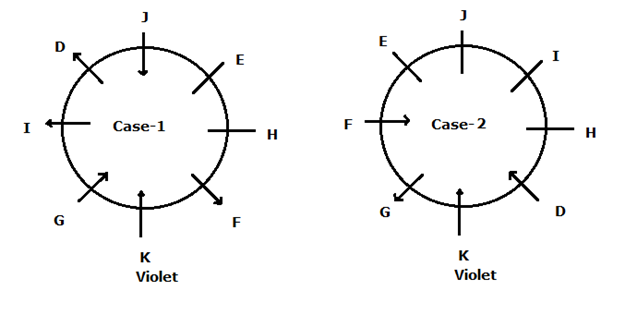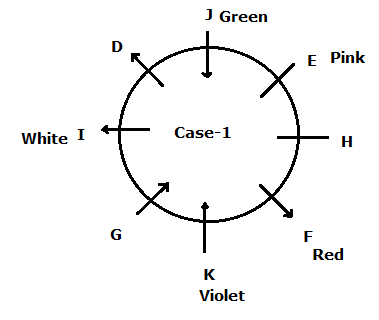In this article we will be discussing about the puzzles for IBPS RRB PO Mains exams. This reasoning section consists of 40 questions that have a weightage of 40 marks. Based on previous year analysis, the puzzles have a weightage of around 20 marks. Most of the aspirants feel that solving puzzles can be time consuming and hence skip this section. Instead, to maintain a good score, the puzzles must be solved in the exam. So, the aspirants should focus on practising puzzles and end up with a good score by not wasting much time.
Types of Puzzles asked in IBPS RRB Mains:
There are many types of puzzles though arrangement based puzzles are asked more frequently in RRB PO exam.
The following are the types of Arrangement based puzzles:
- Circular Seating/standing arrangement with given number of people (facing one direction or both the directions).
- Circular Seating/standing arrangement with a certain number of people.
- Linear Seating/standing arrangement with given number of people (facing one direction or both the directions).
- Linear Seating/standing arrangement with a certain number of people.
- Triangular/ Square/Rectangular shaped seating/standing Arrangements.
- Parallel rows Seating/Standing arrangement.
- Randomly arranged puzzles.
Enroll For Ace the Puzzles 2.0
Ace the Puzzles 2.0 : Features
| Price – 399 |
| Complete Coverage of Puzzles Questions in Reasoning |
| 10+ Classes to Strengthen the concept of All Puzzles |
| Live Practice Sessions to Simulate Real Time Exam Environment |
| 80+ Questions practiced in the guidance of Faculty |
| Useful for ALL Banking, SSC, Railways, Insurance and other Government Exams |
| Special Tricks and Tips which will help save time |
| Class Provided by the Best & Most Experienced Faculty in India |
| Complete coverage of approach, strategy, basic concepts |
Enroll For Ace the Puzzles 2.0
How to solve Puzzles for IBPS RRB Mains:
Solving puzzles of IBPS RRB requires a smart work that includes Strategy, Practice and Time management. If we do this definitely by the end of the day we will get a good score otherwise we will lose our marks.
Strategy: “A perfect strategy can lead any failure to success”
Strategy is important in solving puzzles for IBPS RRB exams. Firstly, read the whole question and then you will get an idea how to solve it and also how much time is taken to solve it and then solve it. Like this if you make a strategy regarding puzzles, you will score good marks.
Practice: “Practice can make a man perfect”
Practicing a lot of examples and questions can lead to consumption of less time for solving puzzles. It also gives you an idea about the puzzles given in exam whether it is less time consuming or more time consuming, easy or moderate, etc..
Attempt a FREE IBPS RRB Officer mock test.
Time Management:
This will play a key role in solving the puzzles for IBPS RRB. If you solve a puzzle taking less time, then you can answer the 4-5 related questions and earn 4-5 precious marks. On the other hand, if a puzzle is solved taking a very long time, it will waste your time for other questions.
Cross out your weak areas by attempting the topic tests on Reasoning.
Practice Questions of Puzzles for IBPS RRB Mains:
Directions(1-5): Study the following Information and answer the related questions:
Eight persons of a family went to a party and seated around a circular dining table such that some are facing away from the center while some are facing towards the center. No three persons facing the same direction are seated together. Each of them have a different coloured handkerchief.
Note: If two persons are facing the same direction then one person is facing towards the center and another person is also facing towards the center and vice-versa. If two persons are facing the opposite directions then one person is facing towards the center and another person is facing away from the center and vice-versa.
Two persons sits between F and I. D sits second to the left of G such that both G and D are facing opposite directions. K sits opposite to J. K faces the center. H sits second to the right of K who have violet coloured kerchief. J is the neighbour of E such that both faces the same direction. F is neither adjacent to J nor to D. F does not face the same direction as G. The one who have pink coloured handkerchief sits opposite to G. I has white coloured handkerchief. The one who have red coloured kerchief sits third to the left of both green coloured kerchief and white coloured kerchief. The one who have brown coloured kerchief seated third to the right of the one who have blue coloured kerchief. The one who has yellow coloured handkerchiefis sitting opposite to a person who faces towards the center.
1. Who among the following have yellow coloured handkerchief?
(a) J
(b) G
(c) E
(d) F
(e) H
2. Who sits opposite to D?
(a) E
(b) H
(c) F
(d) I
(e) K
3. Who among the following sits second to the right of the one who have blue coloured handkerchief?
(a) The one who have pink coloured handkerchief
(b) The one who have violet coloured handkerchief
(c) The one who have brown coloured handkerchief
(d) The one who have red coloured handkerchief
(e) The one who have green coloured handkerchief
4. Who sits opposite to the one who have red coloured kerchief?
(a) D
(b) E
(c) K
(d) H
(e) I
5. H have _______ coloured handkerchief
(a) Red
(b) Pink
(c) White
(d) Green
(e) Brown
Common Solution:
K sits opposite to J. K faces the center. H sits second to the right of K who have violet coloured kerchief. J is the neighbour of E such that both faces the same direction.

Two persons sit between F and I. D sits second to the left of G such that both G and D are facing opposite directions. F is neither adjacent to J nor to D. F does not face the same direction as G. No three persons facing the same direction are seated together.

The one who have pink coloured handkerchief sits opposite to G. I has white coloured handkerchief. The one who have red coloured kerchief sits third to the left of both green coloured kerchief and white coloured kerchief.
Hence case-2 is invalid because I sits opposite to G in case-2 in which I has white coloured handkerchief.

The one who have brown coloured kerchief seated third to the right of the one who have blue coloured kerchief. The one who has yellow coloured handkerchief is sitting opposite to a person who faces towards the center.

Hence this is the final arrangement. So, the solutions are:
1. Answer key: b
G have Yellow coloured handkerchief.
2. Answer key: c
F sits opposite to D.
3. Answer key: a
The one who have pink coloured handkerchief sits second to the right of the one who have blue coloured handkerchief
4. Answer key: a
D sits opposite to the one who have red coloured kerchief.
5. Answer key: e
H has brown coloured handkerchief.
We hope this article will help you tackle the arrangement puzzles in exams. For more such practice questions, register with Oliveboard now.
Register with Oliveboard to crack any bank exam.
Ace your preparation with free mock tests and topic tests.
Study at your own convenience anywhere. Download the Oliveboard app now!

The most comprehensive online preparation portal for MBA, Banking and Government exams. Explore a range of mock tests and study material at www.oliveboard.in
